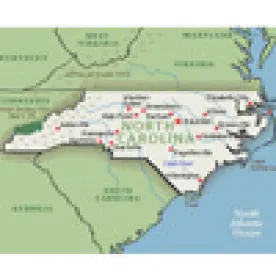Chief Superior Court Judge James H. Pou Bailey informed lawyers - “Justice under the law is like buying a suit off the rack. It doesn’t fit anybody perfectly, but it fits a lot of people fairly well.”
Sometimes, an unpublished opinion contains informative illustrations. Although it is not controlling legal authority and citation to it is disfavored, an unpublished opinion provides typical examples – how the already-made suit of justice under the law fits a situation.
In our last blog post, we discussed Cherry v. Wiesner, a published North Carolina Court of Appeal’s opinion. In Cherry, the North Carolina Court of Appeals affirmed dismissal of an appeal brought by a neighbor living across the street from the alleged misapplication of historic district rules because she failed to allege standing. In that blog post, we suggested that a newly-made limited suit for standing might be appropriate for property located in historic districts because historic district zoning laws regulate the appearances of building exteriors. Specifically, we suggested that consideration of the arguments for and against the court crafting a newly-made limited suit for standing in historic districts was worthy of consideration because the answer affected all properties in historic districts, and would provide the definitive rule applicable to these special districts.
Two weeks after publishing Cherry, the North Carolina Court of Appeals decided another standing case involving a challenge by an adjacent property owner where none of the property was located in a historic property district. In Sugar Mountain Ski Resort v. Village of Sugar Mountain (2016 WL 791132)(March 1, 2016)(Unpublished) the North Carolina Court of Appeals affirmed the Superior Court’s denial of a motion to dismiss the appeal for lack of standing. The Court of Appeals concluded that the adjacent property owner had alleged standing and showed special damages.
In other words, the adjacent property owner’s pleading and evidence in Sugar Mountain fit the ready-made suit of standing.
Sugar Mountain Resort v. Village of Sugar Mountain and Round Boys, LLC
Facts
Round Boys LLC (RB) purchased a house located on a slope adjacent to Sugar Mountain Resort’s (SMR) ski slopes. The house’s deck was less than 2½ feet from SMR’s property line and violated the existing setback requirement of the Village of Sugar Mountain (VSM). However, the deck had been allowed to remain because it had been built prior to VSM’s adoption of its zoning ordinance.
RB demolished a portion of the non-conforming deck and simultaneously applied for a variance to expand further into the setback by building new construction. At the hearings held by the Board of Adjustment (Board) considering RB’s variance request, RB agreed to restrict its new construction to remain within the footprint of the original encroachment. Based upon this agreement, the Board concluded that no variance was required and approved issuance of a Zoning Compliance Permit.
SMR appealed the Board’s decision to Superior Court, and filed a motion in Superior Court requesting a temporary restraining order and preliminary injunction (Injunctive relief) to halt construction in the setback until SMR’s appeal was decided. In its petition for writ of certiorari, SMR alleged:
Petitioner has standing…in that it is the owner of property that is adjacent to property which is the subject of the Board’s Order being appealed by this Petition and will suffer special damages as a result of the Board’s Order in that the Board’s Order allows additional construction and improvements to real property adjacent to a ski slope and within the prohibited [setback] area of the Village and the additional construction and improvements have the potential to affect safety and to create a damage to the general health, safety and welfare of the Village. Sugar Mountain, p.4 (Emphasis by the Court).
Two surveys showing the location of pre-existing and new construction in the setback were in the record. In support of its motion for injunctive relief, SMR proffered an affidavit signed by its manager stating in more detail the facts supporting SMR’s allegation of special damages. SMR’s manager stated that the construction of the new improvements “would potentially interfere with skiing operations,” and the new structure added in the setback area “itself could pose an increased risk to the general safety and welfare of the public.”
Asserting that SMR lacked standing, RB filed a motion to dismiss SMR’s appeal. The Superior Court denied RB’s motion and remanded the case to the Board because the Board had “failed to make findings of fact or conclusions of law in the [Board’s] order so that [the superior court could] properly perform its function.” RB appealed the Superior Court’s denial of its motion to dismiss for lack of standing to the North Carolina Court of Appeals.
Decision
After reviewing SMR’s pleading, the surveys and SMR’s manager’s affidavit, the Court of Appeals concluded that SMR had “sufficiently alleged (1) that the improvements that the Board allowed were unlawful… in that they were located ‘within the prohibited [setback] area’ and (2) that the resort would suffer ‘special damages’ in the form of interfering with skiing operations and reducing the safety of the resort’s ski slopes for members of the public who are guests and patrons of the resort.” Sugar Mountain p.5.
In reaching this conclusion, the Court rejected two legal arguments proffered by RB. First, RB contended that the proposed improvements would not alter the existing setback or increase or alter the pre-existing nonconformity. Therefore, SMR could not suffer special damages. As for this argument, the Court reviewed the record and noted that RB’s variance application proposed an expansion of the home and construction within 2 1/2 feet of the property line. In other words, while the record was unclear, there was evidence prepared by RB that seemed to contradict RB’s first legal argument.
In its second argument, RB contended that the Board’s determination that the proposed improvements would not increase the footprint of the structure conclusively established that the proposed improvements were lawful uses. The Court of Appeals rejected this argument emphatically. The Court observed that “were we to accept the owner’s reasoning, no zoning board decision finding a requested use to be ‘permitted’ could ever be questioned, no matter how erroneous the board’s determination might actually be.” Sugar Mountain p.4.
Comments
1. Sugar Mountain illustrates the importance of standing. When a party considers appealing a governmental land use decision that which entitles a use on another owner’s property, an essential first step is identifying the (1) illegal use permitted by the decision and (2) the special damages arising from this illegal use.
2. The concept of standing is quite simple. At the point a party invokes the jurisdiction of a court by filing a case, the party must show to the court at that time and continuously thereafter during the entire proceeding that the dispute practically matters.
In Sugar Mountain, the record showed that determining whether the Board’s decision was erroneous mattered practically. An erroneous decision would allow an illegal use on adjacent property and “special damages in the form of interfering with skiing operations and reducing the safety of the resort’s ski slopes for members of the public who were guests and patrons of the resort” could flow from the illegal use. The case fit the already-made suit of standing.




 />i
/>i

